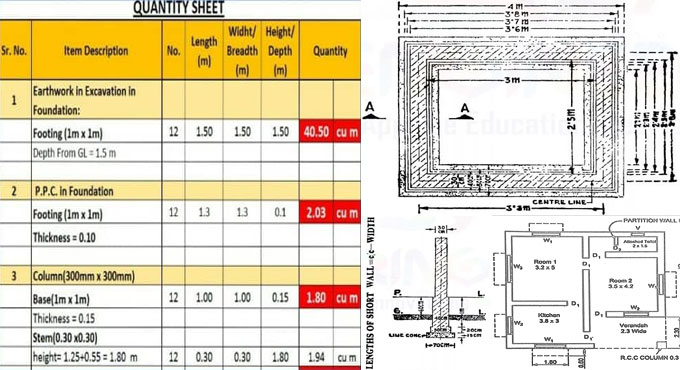
Three Methods of Estimating Building Works
When you need to erect a building, you have to estimate its quantities. There are many kinds of quantities you have to calculate, like earthwork in excavation, foundation concrete, brickwork in foundation and still more. You can use one of the main three methods of estimating building works ? today we will discuss each of them.
The three main ways to calculate quantities for building works are:
1. Center line method
2. Long and short wall method
3. Crossing method
Now let us go and observe each method in detail.
Center Line Method
Possibly the easiest among the three methods of estimating building works, the center line method is arguably the most favored among the constructors.
However, as you will find out below, this method may be erroneous or inaccurate as well. So, you have to consider adding some extras with the results from the center line method.
In this method, first, you find the center line of each and every wall in the building. Then you join up the length of those lines, which gives you the total wall length in the building in question. Finally, the total length is multiplied by the breadth and depth of the walls to get the total quantity estimate.
As you may have already realized, this wouldn?t give the correct results for buildings with different wall thicknesses. In that case, this method will have to be run separately for each type of wall, and then add up the results.
The main disadvantages of this method of finding out the building work quantities comes when you need to add some irregular kind of wall in the building. For example, with an unsymmetrical wall, this method will be useless ? you have to calculate that wall completely in a separate case.
However, if the building has irregular walls like circular or curved walls, or many walls intersecting at odd angles (other than 90 degrees), but of the same thickness and height then the center line method works beautifully and quite accurately.
Long and Short Wall Method
It is a complicated method, but the long and short wall method is quite accurate and useful. In this method, first you have to assume the longer walls in a given direction as ?long walls? and the walls perpendicular to them will be taken as ?short walls? - make sure you have mostly longer walls in the direction you choose.
The insides of the short walls are measured for the given type of building work. And now the outsides of the long walls are measured. These two values are then multiplied by the breadth and height of the walls (assuming they are all of the same height). The results are added to get the quantity estimate.
The beauty of this method is, obviously, the flexibility. As long as you have rectangular or square rooms in the building, it doesn?t matter what thickness the walls have ? those values are completely ignored. However, trouble starts if your rooms have different shapes, like trapezoidal, or if they have more than four parts of walls.
In some real-world cases, you will notice that one or two walls in the building may be troublesome, thought theoretically they shouldn?t. In these cases, you may notice that the same wall, considered from one end is taken as a long wall, but is a short wall if considered from the other end. This happens when a long wall intersects another previously considered long wall.
In this case, to uncomplicate matters, the joining end of the wall that you are considering now is taken as a short wall, instead of the end of long wall. Then the quantity is calculated according to the above method. This type of walls is called long-short walls in a building work.
Crossing Method
A rather obsolete method today, the Crossing method happens to be quite precise, but is almost never used now due to the complexity.
In this method, you have to calculate the overall perimeter of the building first. Then, you have to subtract four times of the wall breadth to get the center line of the wall. Then you can proceed similarly as the above methods. As said before, this method can be quite confusing and so it is not used anymore.


